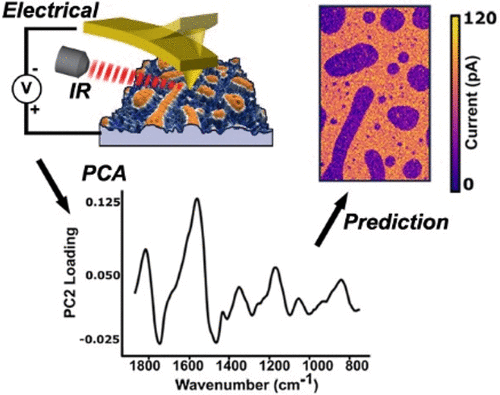当前位置:
X-MOL 学术
›
J. Phys. Chem. Lett.
›
论文详情
Our official English website, www.x-mol.net, welcomes your
feedback! (Note: you will need to create a separate account there.)
Identifying Nanoscale Structure–Function Relationships Using Multimodal Atomic Force Microscopy, Dimensionality Reduction, and Regression Techniques
The Journal of Physical Chemistry Letters ( IF 4.8 ) Pub Date : 2018-05-31 00:00:00 , DOI: 10.1021/acs.jpclett.8b01003 Jessica Kong 1 , Rajiv Giridharagopal 1 , Jeffrey S. Harrison 1 , David S. Ginger 1
The Journal of Physical Chemistry Letters ( IF 4.8 ) Pub Date : 2018-05-31 00:00:00 , DOI: 10.1021/acs.jpclett.8b01003 Jessica Kong 1 , Rajiv Giridharagopal 1 , Jeffrey S. Harrison 1 , David S. Ginger 1
Affiliation

|
Correlating nanoscale chemical specificity with operational physics is a long-standing goal of functional scanning probe microscopy (SPM). We employ a data analytic approach combining multiple microscopy modes using compositional information in infrared vibrational excitation maps acquired via photoinduced force microscopy (PiFM) with electrical information from conductive atomic force microscopy. We study a model polymer blend comprising insulating poly(methyl methacrylate) (PMMA) and semiconducting poly(3-hexylthiophene) (P3HT). We show that PiFM spectra are different from FTIR spectra but can still be used to identify local composition. We use principal component analysis to extract statistically significant principal components and principal component regression to predict local current and identify local polymer composition. In doing so, we observe evidence of semiconducting P3HT within PMMA aggregates. These methods are generalizable to correlated SPM data and provide a meaningful technique for extracting complex compositional information that is impossible to measure from any one technique.
中文翻译:

使用多峰原子力显微镜,降维和回归技术识别纳米级结构与功能的关系
将纳米级化学特异性与操作物理学相关联是功能扫描探针显微镜(SPM)的长期目标。我们采用了一种数据分析方法,该方法结合了多个显微镜模式,这些模式使用了通过光诱导力显微镜(PiFM)获取的红外振动激发图中的成分信息和来自导电原子力显微镜的电信息。我们研究了包含绝缘聚甲基丙烯酸甲酯(PMMA)和半导体聚(3-己基噻吩)(P3HT)的模型聚合物共混物。我们表明,PiFM谱不同于FTIR谱,但仍可用于识别局部成分。我们使用主成分分析来提取具有统计意义的主成分,并使用主成分回归来预测局部电流并识别局部聚合物成分。在这样做,我们观察到PMMA聚集体中半导体P3HT的证据。这些方法可通用化以关联SPM数据,并提供了一种有意义的技术来提取无法从任何一种技术进行测量的复杂成分信息。
更新日期:2018-05-31
中文翻译:

使用多峰原子力显微镜,降维和回归技术识别纳米级结构与功能的关系
将纳米级化学特异性与操作物理学相关联是功能扫描探针显微镜(SPM)的长期目标。我们采用了一种数据分析方法,该方法结合了多个显微镜模式,这些模式使用了通过光诱导力显微镜(PiFM)获取的红外振动激发图中的成分信息和来自导电原子力显微镜的电信息。我们研究了包含绝缘聚甲基丙烯酸甲酯(PMMA)和半导体聚(3-己基噻吩)(P3HT)的模型聚合物共混物。我们表明,PiFM谱不同于FTIR谱,但仍可用于识别局部成分。我们使用主成分分析来提取具有统计意义的主成分,并使用主成分回归来预测局部电流并识别局部聚合物成分。在这样做,我们观察到PMMA聚集体中半导体P3HT的证据。这些方法可通用化以关联SPM数据,并提供了一种有意义的技术来提取无法从任何一种技术进行测量的复杂成分信息。











































 京公网安备 11010802027423号
京公网安备 11010802027423号